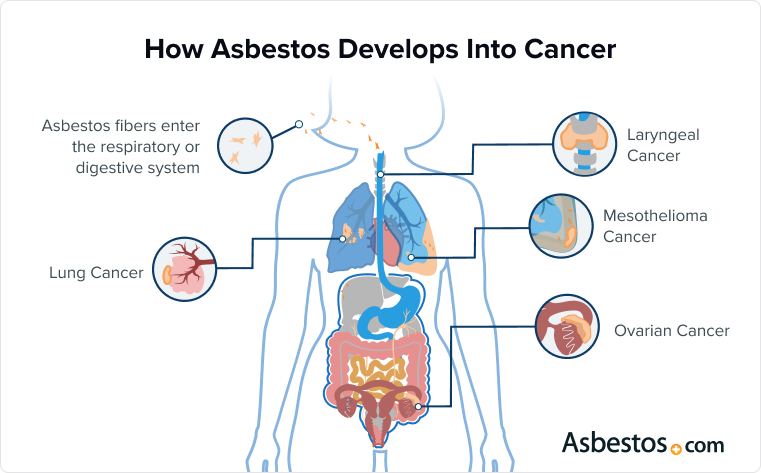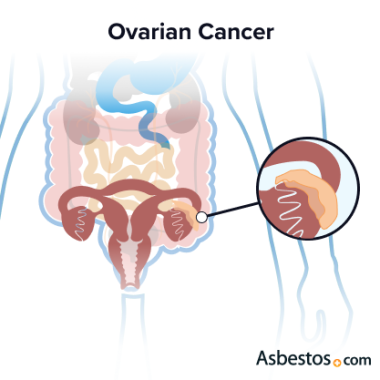Get Your Free Mesothelioma Guide

Find a Top Mesothelioma Doctor

Access Help Paying for Treatment

Asbestos exposure causes cancers such as mesothelioma, lung cancer, laryngeal cancer and ovarian cancer. Mesothelioma and lung cancer are the most prevalent. Most mesothelioma cases arise from exposure to asbestos.
Asbestos causes cancer when its fibers are inhaled or ingested. They can become stuck within sensitive tissue around your lungs or abdomen, causing inflammation and cell damage over many years.
As the fibers damage DNA over time, the genetic changes lead to abnormal cell growth and cancer. Exposure to asbestos causes half of all occupational cancer deaths.
Occupational exposure from many blue-collar professions is the leading cause of asbestos-related diseases. The U.S. military has used asbestos throughout the past century, causing asbestos cancer in thousands of veterans.
Asbestos can also contaminate products that contain other minerals such as talc. The presence of asbestos in talc increases your risk of developing various cancers, including ovarian cancer and mesothelioma.
Asbestos is known to cause mesothelioma, lung cancer, laryngeal cancer and ovarian cancer. Mesothelioma and lung cancer are the most frequently diagnosed types of asbestos cancer. Most types of mesothelioma occur 20 to 60 years after the initial asbestos exposure.

As a comprehensive analysis published March 2024 on the global burden of occupational asbestos exposure reports, “Asbestos fibers are mainly inhaled with air, and have local carcinogenic effects on target organs (lungs, larynx, ovaries) and related serous membranes (pleura, pericardium, peritoneum, vaginal membranes), resulting in lung cancer, larynx cancer, ovarian cancer, pleura, and peritoneal mesothelioma.” The authors emphasized no amount of asbestos exposure is safe.
The authors also noted that asbestos-related ovarian cancer “has been designated as the first gynecological occupational disease in Germany.” It was also noted that “the risk of ovarian cancer was approximately doubled in females with occupational asbestos exposure.”
Inhaled asbestos fibers can lodge in your voice box as they pass through your trachea, or windpipe, on the way to the lungs. A combination of smoking, heavy drinking and asbestos exposure significantly increases the risk of laryngeal cancer.
About 12,650 cases of laryngeal cancer will occur in 2024, according to the American Cancer Society. In 2021, researchers discovered that 50% of workers with a history of occupational asbestos exposure had chrysotile asbestos fibers near the tumor sites.
Asbestos-related lung cancer kills twice as many Americans each year as mesothelioma. Asbestos exposure is the primary cause of about 4% of lung cancer cases. About 234,580 new cases of lung cancer associated with any cause will occur in 2024.
Unlike mesothelioma, lung cancer develops inside your lungs. Combining tobacco and asbestos exposure significantly increases the risk of developing lung cancer, but not mesothelioma. About 63% of patients diagnosed with localized lung cancer live 5 years or more. Conversely, the 5-year survival is 7% for lung cancer patients with late-stage or distant metastatic disease.
Get Your Free Mesothelioma Guide

Find a Top Mesothelioma Doctor

Access Help Paying for Treatment

About 75% of mesothelioma cancers form in the protective lining of the lungs, known as the pleura. Approximately 20% of mesothelioma cases develop in the abdominal lining, known as the peritoneum. A recent research study discovered that 80% of pleural mesothelioma patients have a history of direct or indirect asbestos exposure.
Another recent research paper noted an estimated 43,000 deaths occur globally every year from mesothelioma and asbestos-related diseases, or roughly 5 to 10 deaths every hour. The average life expectancy for mesothelioma patients is 12 to 21 months with treatment.

Ovarian cancer involves abnormal growth of cells within your ovaries. In 2024, approximately 19,680 women will receive a diagnosis of ovarian cancer. Ovarian cancer is the fifth most common cancer among women. It causes more deaths than other female reproductive cancers.
Recent medical research has established that asbestos exposure is one cause of ovarian cancer, which was first confirmed in 2009. A study found evidence of asbestos fibers in 80% of talcum powder product-related ovarian cancer cases.
There is a correlation between asbestos exposure and other types of cancer. The International Agency for Research on Cancer and other groups are conducting ongoing research to determine if asbestos is a definitive cause of these cancers.
The IARC has identified 3 types of cancer “positively associated” with asbestos exposure: Pharyngeal, stomach and colon cancer. This means there is some evidence of a link but not strong enough data to conclude asbestos definitively causes these diseases.
Many risk factors for cancers that get the least attention involve exposure to toxic materials. Asbestos can damage sensitive organs throughout the body and eventually cause cancer. If you have experienced exposure or have a family history of cancer, inform your provider.
The most common symptoms of mesothelioma and other asbestos cancers include breathing problems, digestive issues, fatigue, fever and pain. The earliest symptoms can mimic more common respiratory or abdominal cancers. Asbestos cancer symptoms differ depending on the location of your tumors. Notifying your doctors of symptoms is the best way to receive an early diagnosis. An early and accurate diagnosis can improve your survival and the options to treat mesothelioma and other cancers.
If you have a history of asbestos exposure, talk to your doctor about regular health screenings. They should pay special attention to signs that may signal cancer.
In addition to the physical effects of cancer, over time, long periods of pain can cause emotional symptoms as well. These can include stress, fear, anxiety and depression.
Surgery, chemotherapy and radiation are the primary treatment options for asbestos cancer. Treatment success varies, and what works well for one patient may be ineffective for another.
The best route is to find a doctor specializing in mesothelioma and other asbestos cancers. They’ll evaluate your health and medical history to develop a treatment plan. A specialist often develops a multimodal treatment plan that includes several approaches.
Each type and stage of cancer requires a different treatment. For example, surgery is most effective in early-stage peritoneal disease. Chemotherapy can help prevent cancer growth or recurrence.
Treatment for asbestos cancer can incur high costs, including travel expenses to cancer centers. Clinical trials can offer a chance at free or low-cost emerging therapy. Our Financial Aid for Cancer Patients Guide also outlines a number of types of financial compensation.
Asbestos manufacturers and companies that use asbestos products are responsible for preventing asbestos exposure among their employees and the general public. Regulations require employers to put safety measures in place to eliminate the threat of asbestos.
If you work in an industry where asbestos is present, talk to your employer about proper safety protocols. Employers should provide protective equipment and safety training.
Even with laws restricting use, people may still be exposed today. Firefighters, construction workers and military personnel can encounter asbestos in older buildings damaged in fires, renovations and demolition and combat. Wearing protective gear where asbestos may be disturbed is essential.
People exposed to asbestos 20 to 60 years ago may only be diagnosed with related cancers now. If you have a history of asbestos exposure, alert your doctor. Screening tests can detect early signs of asbestos cancer.
If you’ve experienced an asbestos-related injury or illness, our Patient Advocates can help you find a specialist, file your VA-benefits claims and connect with an asbestos cancer attorney. An experienced lawyer can help you file an asbestos trust fund claim or lawsuit seeking compensation.
Recommended ReadingYour web browser is no longer supported by Microsoft. Update your browser for more security, speed and compatibility.
If you are looking for mesothelioma support, please contact our Patient Advocates at (855) 404-4592
The Mesothelioma Center at Asbestos.com has provided patients and their loved ones the most updated and reliable information on mesothelioma and asbestos exposure since 2006.
Our team of Patient Advocates includes a medical doctor, a registered nurse, health services administrators, veterans, VA-accredited Claims Agents, an oncology patient navigator and hospice care expert. Their combined expertise means we help any mesothelioma patient or loved one through every step of their cancer journey.
More than 30 contributors, including mesothelioma doctors, survivors, health care professionals and other experts, have peer-reviewed our website and written unique research-driven articles to ensure you get the highest-quality medical and health information.
My family has only the highest compliment for the assistance and support that we received from The Mesothelioma Center. This is a staff of compassionate and knowledgeable individuals who respect what your family is experiencing and who go the extra mile to make an unfortunate diagnosis less stressful. Information and assistance were provided by The Mesothelioma Center at no cost to our family.LashawnMesothelioma patient’s daughter


Asbestos.com. (2024, December 6). Asbestos Cancer. Retrieved March 27, 2025, from https://www.asbestos.com/cancer/
"Asbestos Cancer." Asbestos.com, 6 Dec 2024, https://www.asbestos.com/cancer/.
Asbestos.com. "Asbestos Cancer." Last modified December 6, 2024. https://www.asbestos.com/cancer/.
Dr. Jacques Fontaine is a thoracic surgeon at Moffitt Cancer Center in Tampa, Florida, where he heads up the Mesothelioma Research and Treatment Center. He specializes in minimally invasive robotic surgery and aggressive surgeries for mesothelioma.
Our fact-checking process begins with a thorough review of all sources to ensure they are high quality. Then we cross-check the facts with original medical or scientific reports published by those sources, or we validate the facts with reputable news organizations, medical and scientific experts and other health experts. Each page includes all sources for full transparency.
Please read our editorial guidelines to learn more about our content creation and review process.
We Thoroughly vet individuals who are experts in their field to contribute to articles on Asbestos.com. We believe in the integrity and quality of our educational materials, and only publish information that is relevant, factual, and backed by experts.
